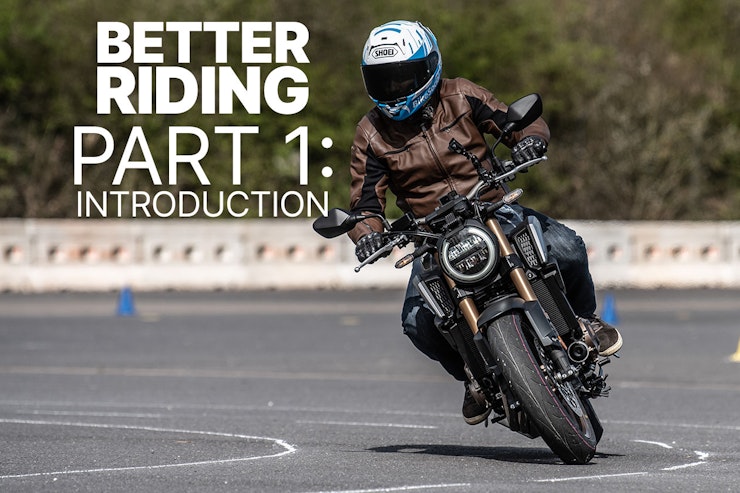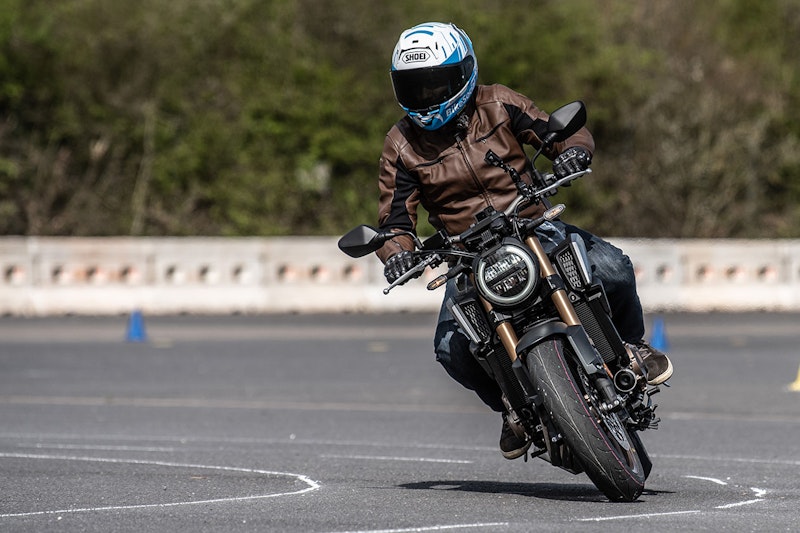Better Riding: Introducing our motorbike coach
By Michael Mann
BikeSocial Managing Editor
03.10.2024
This motorcycle riding coach is about to shake up the industry! Ok, it’s a bold statement but hear me out because this is the preview of our Better Riding series designed to ramp up your enjoyment of riding by being safer and smoother. We’re aiming to help you get more out of your motorcycling, and we’ve got a proper pro lined up.
Massive thanks to Honda Motorcycles UK for supporting this series.
Before we meet the guy who’s developed a new system to upgrade your riding, let me ask you this - everyone can become better at riding – if not, then why do the world’s greatest racers still need rider coaches? Rossi, Marquez, Bagnaia, Milbank… they all rely on information, data and advice to raise their game. Some of those guys are looking at saving fractions of a second but how many times have you ridden around a corner - and it might even be on your favourite stretch of road - and thought, “damn, I could have taken that corner better, faster, smoother, more confidently”?
Better Riding has an emphasis on making rider training aspirational. Here’s another question - once David Beckham realised he could kick a ball rather well, did he stop practicing? Or when Jimi Hendrix strummed his first chord, did he put the guitar down? No. They and the billions of people around the world who enjoy a hobby keep on practicing to get better at it. Do we as motorcyclists focus on practicing? Or, do we think that with experience comes greatness? Or “survival equals competence,” as BikeSocial boss, Steve Rose, wrote here just last month. We need to want to get better because passionate people spend time and money to get better at the thing they love. Beckham, Hendrix et al. spend tens of thousands of hours practicing, yet how many hours does it take to pass your CBT and the current two-part bike test? 30, give or take. Then what… do we focus on practicing the right techniques, or identifying how we can evolve that passion?
How will Better Riding help?
At the time of writing our aim is to record and present in video and written form, five episodes that dissect the essential elements of motorcycle control that aren’t included in the bike test, and if just one person ends up learning one new element it’ll be considered a success, but we’re hoping to help:
Learn new skills and techniques (bike control)
Read the road and take control of their ride (roadcraft)
Make the right decisions… faster (mindset)
Get more from your motorcycling
The more appetite there is for this content, the more technical and advance we’ll get with future series already being planned. But first, allow me to introduce our professional Motorbike Coach, Mark McVeigh, an experienced rider coach, an ex-MotoGP engineer, a riding academy owner for over 20 years and the inventor of motoDNA rider training tech. You can follow Mark at www.motorbikecoach.com
Better Riding – an introduction
How to be a safer, smoother and more confident motorcycle rider
INTERVIEW: Mark McVeigh
Mark, you are very much going to be leading this project and offering every nugget from your immense brain and vast experience, but before we get into the details of why your system and syllabus is different - and as plot spoiler it’s based on three elements: skills, roadcraft and mindset - let’s get to know you and why we should trust you, a thought leader in motorcycle training, a bit like a 21st century Keith Code:
Why do we need to know what you’re going to teach us?
The motorcycle industry is in a bit trouble. The average rider age is now 50+ years old in many countries including in the UK. The main reason is crashes, deaths and injuries is keeping young riders away, or else motorcycling will fade away. So better riding = safer riding = reduced accident rate = government understanding that motorcycling isn’t just about hoodlums, noise and deaths. We’re going to fix it with the right kind of training, a modern riding system that will available online that uses data and research to save motorcycling.
Sadly, it all started when my best mate, Davey, was killed on the road, we were all a little bit crazy as bullet-proof young men, so I decided to go racing instead which probably saved my life. My first race in 1990 on a Yamaha 350 Power Valve which I rode to the race. I was runner-up in the Irish 250GP club championship, and in 1993 represented Ireland at international level in the European Championships and the Sunflower Race alongside the likes of Simon Crafer, Jeremy McWilliams, Regis Laconi and Olivier Jacque. I still race now in the Superbike Masters in Australia on an FZR1000 – 160hp and 160kg with no electronic aids, that keeps me on my toes!
How did you end up working in the MotoGP paddock?
Once I ran out of money, talent and ambition, I was an engineer and initially was lucky enough to get into the 500 2-stroke era with Jeremy McWilliams doing everything from datalogging to rebuilding the engines. So that was a hoot. Then I went back in the 4-stroke era specialising on the cooling systems, and working with the factories directly in MotoGP and World Superbikes. And then I did a bit of work with some of the teams working on a dynamic chassis, which today would be called the Ride Height Device, that was a lot of fun but during that period I got a real understanding on how riders work and how motorcycles work.
At this point you’ve got racing experience, a wealth of contacts in the GP paddock and beyond, and a yearning to develop rider skills to eliminate so many accidents. How did you start to gel all that together?
I started looking at a bit of psychology to understand how rider’s brains worked and how my brain work. And I came across Dunning Kruger’s Nobel prize winning study which provided evidence of human’s cognitive bias of illusory superiority. Essentially how experience and confidence mix. So I tried to work out the human need for Autonomy, Mastery and Purpose, and thought well I know a lot about this and have since tried to use my experience and understanding to save motorcycle riders lives.
You then moved on to set up a motorcycle training school, but how do achieve that? Do you need any qualifications?
Anybody can become a rider trainer unless you do the licensing you’ve got to go through some basic qualifications which are quite rudimentary. We really focused on post-licence training and when I looked what was out there versus my experience of riding and engineering, understanding riders and psychology, and motorbike dynamics, the training that was around was very rudimentary. We actually started training kids at the school but we needed more money to support that program when we started training road rider which is when we developed the three pillars of skill, craft and mind. That’s essentially what you need to ride a bike well, safely and to have fun as well. The skill element is about machine control – how closely can you match the performance of the bike and the tyre. The craft is road craft, how to predict, hazard awareness. And then there’s the mind, and nobody was really doing anything about the mind, and that’s your attitude to continue improving mindset and doing the right thing in the spirit of the law. So we developed a junior program to begin with and that got accredited by DORNA, and we’ve literally got hundred of racers than have gone on to compete internationally. Even today we’ve got Joel Kelso and Jacob Roulstone in Moto3, and then in Moto2 we’ve got Senna Agius as well. While the racing stuff is more fun, it’s more the road riders we’re focusing on.
How much of an expert do we become if we practice the right riding for 10,000 hours?
It’s a good point, I think it was Malcom Gladwell in his book, Outliers’ spoke about the 10,000 hours, and that’s of deliberate practice, with a coach or a trainer and not with your mates to become an expert. And that does take a long time; if you did eight hours a day, five days a week, it’d take five years to get to 10,000 hours, so it is very significant. And when you think about getting your licence, that’s about 20 hours which isn’t even a percent of what you need for mastery. And during the licencing phase, your ability is actually measured by human. Again, this brings a bit of doubt into the equation. We use a data driven system that actually measures the rider and interprets the data and grades them, so the rider’s can understand their ability. The other thing is, what’s the minimum skill level to be safe? Do you need to do the 10,000 hours? Well that’s probably get you into British Superbikes or racing at a high level, but from our school training thousands of riders we saw that ‘50’ was a good level to have but we were seeing riders who were scoring ’20’ so there was a big skills gap.
The Better Riding series will include information and advice on steering, stopping, cornering with confidence, choosing the right line, overtaking, filtering, as well as avoiding the most common riding errors. We’ll be back very soon with Episode 1 – ‘How to steer a motorcycle’.
If you’d like to chat about this article or anything else biking related, join us and thousands of other riders at the Bennetts BikeSocial Facebook page.

